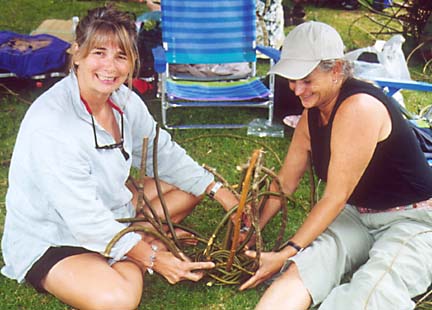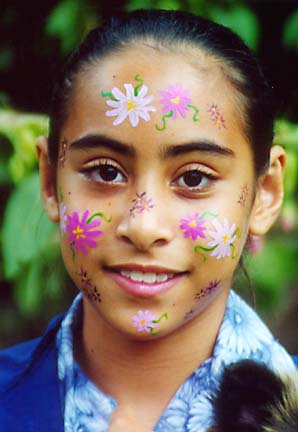

|
Hawaii’s Back yard Cheryl Chee Tsutsumi |

|
Lemons-to-lemonade
philosophy spurs event
to turn poka vines
into works of art
|
But Erickson's philosophy is when you have lemons, make lemonade. Fourteen years ago she helped launch the Banana Poka RoundUp, a day-long outdoor educational fair featuring workshops that teach participants how to transform the invasive banana poka into lovely, durable, functional baskets.
In addition, the fair offers live music; environmental exhibits; games and crafts for the children; a 2 1/2-mile hike along Kokee's scenic Berry Flats Loop; and classes on oshibana, the Japanese art of arranging dried, pressed flowers into eye-catching designs.
Other highlights include lei-making sessions using palapalai fern, agapanthus, hydrangea, pukiawe (black-eyed Susan), fruit clusters from the aalii (a native hardwood tree) and other flowers and foliage gathered from the forest; a crowing contest in which children and adults who sound most like a real chicken receive T-shirts, stuffed animals, movie tickets and other goodies; and the "One Person Can Make a Difference" presentations, which reward outstanding community volunteers in professional, cultural, environmental, group and youth categories with prizes including Na Pali Coast cruises, weekend stays at Waimea Plantation Cottages, dinner certificates and more.
Set for next Sunday at the Civilian Conservation Corps camp in Kokee State Park, the RoundUp kicks off Kokee Museum's summer season of guided hikes and forest craft workshops. This year's event is tied in with the Year of the Hawaiian Forest, a year-long campaign sponsored by the Nature Conservancy, Malama Hawaii (www.malamahawaii. org) and the Department of Land & Natural Resources' Division of Forestry & Wildlife to encourage public stewardship of Hawaii's forests.

|
IN 1982 SHE WAS executive director of the Volcano Art Center on the Big Island, and one of the group's trustees -- fiber artist and children's book author Carole McCarty -- led a basket workshop as a fund-raiser for the nonprofit center. "She taught us how to use the banana poka, a handsome weed that was choking the native forests at Hawaii Volcanoes National Park. I still have the basket I made on that day; they last!"
Five years later, when Erickson moved to Kauai to assume leadership of Hui o Laka, she was surprised to find there was no program to defend Kokee's fragile ecosystem from the intrusion of non-native plants, banana poka being the most aggressive among them.
She remembered McCarty's workshop at the Volcano Art Center and recruited another artist friend, Jennie Hutchings, to conduct a session on banana poka basket-making. Thus began the Banana Poka RoundUp.
"Making baskets out of the banana poka vines is a vehicle to tell the larger story of our precious natural areas and the challenges they face," notes Erickson. "We wanted to make the event fun so families would come to make memories together, in addition to baskets. We wanted to highlight the good work of the many agencies and organizations that keep Kauai beautiful, hence the exhibits."
This year's participants include the Department of Land & Natural Resources' Division of Conservation & Resource Enforcement; U.S. Fish and Wildlife; and Volcano-based Earth Friendly Schools. The latter group works with schools in developing fun environmental activities that teach kids about taking care of our planet. Another participant, the Puaiohi Project, is a captive breeding and release program for the endangered puaiohi, the native Kauai thrush.
Erickson says volunteers pull "miles" of banana poka in Kokee two days before the RoundUp. Areas where the vines are plentiful and have the most potential to establish strongholds are targeted. At the RoundUp, attendees use the harvest to weave baskets while they talk story and enjoy the lush mountain setting of Kokee.
"For me the RoundUp was inspired by the notion of creating positive value out of a challenge," says Erickson. "An old Buddhist concept, 'hendoku iyaku,' means 'to change poison into medicine.' That's what we're trying to do with the basket-making. Folks have a wonderful time unwinding with friends as they tackle the intricacies of turning a wild vine into a basket. Meanwhile, the trees in the forest are liberated from the weight and shade of the banana poka."
EVEN WITH 100 basket makers participating in the RoundUp every year, however, Erickson admits, "We would not rid our forests of all the banana poka. Ours is largely an educational effort."
It was through the Banana Poka RoundUp that more good came about. In 1998, Katie Cassel, the event's coordinator at the time, organized the Kokee Resource Conservation Program as a hard-hitting offensive. Today, throughout the year, more than 1,000 KRCP volunteers tackle the back-breaking task of ridding Kauai's forests of pesky plants and weeds.
The program operates daily except Sunday, with KRCP's conservationists providing labor whenever they can. Some work a few hours a week; others devote a few days a week to the project. Every hand, every minute, makes a difference in the continuing battle.
Meanwhile, Erickson hopes more artisans will consider the potential of non-native invasive plants as materials for their creations. She says, "From wood to vine to bark, these plants could fuel a conservation crafts movement that would turn these aliens into allies while eliminating them as threats to the forests."
and Society of American Travel Writers award winner.